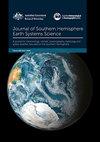Climate sensitivity revisited
IF 3.6
4区 地球科学
Q1 Earth and Planetary Sciences
引用次数: 0
Abstract
The commonly used energy balance model from Gregory et al. (2002) that underlies many published estimates of Equilibrium Climate Sensitivity (ECS) and Transient Climate Response (TCR) to anthropogenic forcing requires only four parameters for calculation of ECS and three for TCR. Both estimates require a value for the increase in global mean surface air temperature (ΔT) over a period of time, the increment in forcing driving the temperature change over that period (ΔF), and knowledge of the radiative forcing resulting from a doubling in CO2 concentration (F2×CO2). For ECS a value for the associated global heating rate (ΔQ) is also required. Each of these parameters has a best estimate available from the IPCC’s Fifth Assessment Report, but the authors did not provide best estimates for ECS and TCR within the broad uncertainty ranges quoted, 1.5–4.5K for ECS and 1.0–2.5K for TCR. Best estimates for ECS and TCR consistent with AR5 best estimates for ΔF and F2×CO2 are provided here. A well-known heuristic model was modified and applied to seven observation-based global temperature datasets to isolate temperature trend due to anthropogenic forcing from confounding effects of variability due to volcanism, cycles in solar irradiance and internal climate variability. The seven estimates of ECS and TCR were remarkably similar despite very large differences in time-base of the datasets analysed, yielding best estimates of 2.36±0.13K and 1.58±0.09K respectively at 95% confidence based on the AR5 best estimates for ΔF, F2×CO2 and ΔQ from Wijffels et al. (2016). The ECS and TCR best estimates here are tied to those AR5 and ΔQ best estimates, but can be simply scaled were those best estimate values to be refined in the future.重新审视气候敏感性
Gregory等人(2002)常用的能量平衡模式是许多已发表的关于平衡气候敏感性(ECS)和短暂气候响应(TCR)的估计的基础,计算ECS和TCR只需要四个参数。这两种估计都需要一个全球平均地表气温在一段时间内的增加值(ΔT)、在这段时间内驱动温度变化的强迫的增加值(ΔF),以及关于二氧化碳浓度加倍所导致的辐射强迫的知识(F2×CO2)。对于ECS,还需要一个相关的全球升温速率值(ΔQ)。这些参数中的每一个都有IPCC第五次评估报告提供的最佳估计,但作者没有在引用的广泛不确定性范围内提供ECS和TCR的最佳估计,ECS为1.5-4.5K, TCR为1.0-2.5K。这里提供了与第五次评估报告一致的ECS和TCR的最佳估计值ΔF和F2×CO2。对一个著名的启发式模型进行了改进,并将其应用于7个基于观测的全球温度数据集,以将人为强迫引起的温度趋势与火山活动、太阳辐照周期和内部气候变率引起的变率混杂效应分离开来。尽管所分析数据集的时间基础存在很大差异,但ECS和TCR的7个估计值非常相似,基于Wijffels等人(2016)对ΔF、F2×CO2和ΔQ的AR5最佳估计值,在95%置信度下分别产生2.36±0.13K和1.58±0.09K的最佳估计值。这里的ECS和TCR最佳估计值与AR5和ΔQ最佳估计值相关联,但可以简单地缩放这些最佳估计值,以便在未来进行改进。
本文章由计算机程序翻译,如有差异,请以英文原文为准。
求助全文
约1分钟内获得全文
求助全文
来源期刊

Journal of Southern Hemisphere Earth Systems Science
Earth and Planetary Sciences-Oceanography
CiteScore
8.10
自引率
8.30%
发文量
0
审稿时长
>12 weeks
期刊介绍:
The Journal of Southern Hemisphere Earth Systems Science (JSHESS) publishes broad areas of research with a distinct emphasis on the Southern Hemisphere. The scope of the Journal encompasses the study of the mean state, variability and change of the atmosphere, oceans, and land surface, including the cryosphere, from hemispheric to regional scales.
general circulation of the atmosphere and oceans,
climate change and variability ,
climate impacts,
climate modelling ,
past change in the climate system including palaeoclimate variability,
atmospheric dynamics,
synoptic meteorology,
mesoscale meteorology and severe weather,
tropical meteorology,
observation systems,
remote sensing of atmospheric, oceanic and land surface processes,
weather, climate and ocean prediction,
atmospheric and oceanic composition and chemistry,
physical oceanography,
air‐sea interactions,
coastal zone processes,
hydrology,
cryosphere‐atmosphere interactions,
land surface‐atmosphere interactions,
space weather, including impacts and mitigation on technology,
ionospheric, magnetospheric, auroral and space physics,
data assimilation applied to the above subject areas .
Authors are encouraged to contact the Editor for specific advice on whether the subject matter of a proposed submission is appropriate for the Journal of Southern Hemisphere Earth Systems Science.
 求助内容:
求助内容: 应助结果提醒方式:
应助结果提醒方式:


